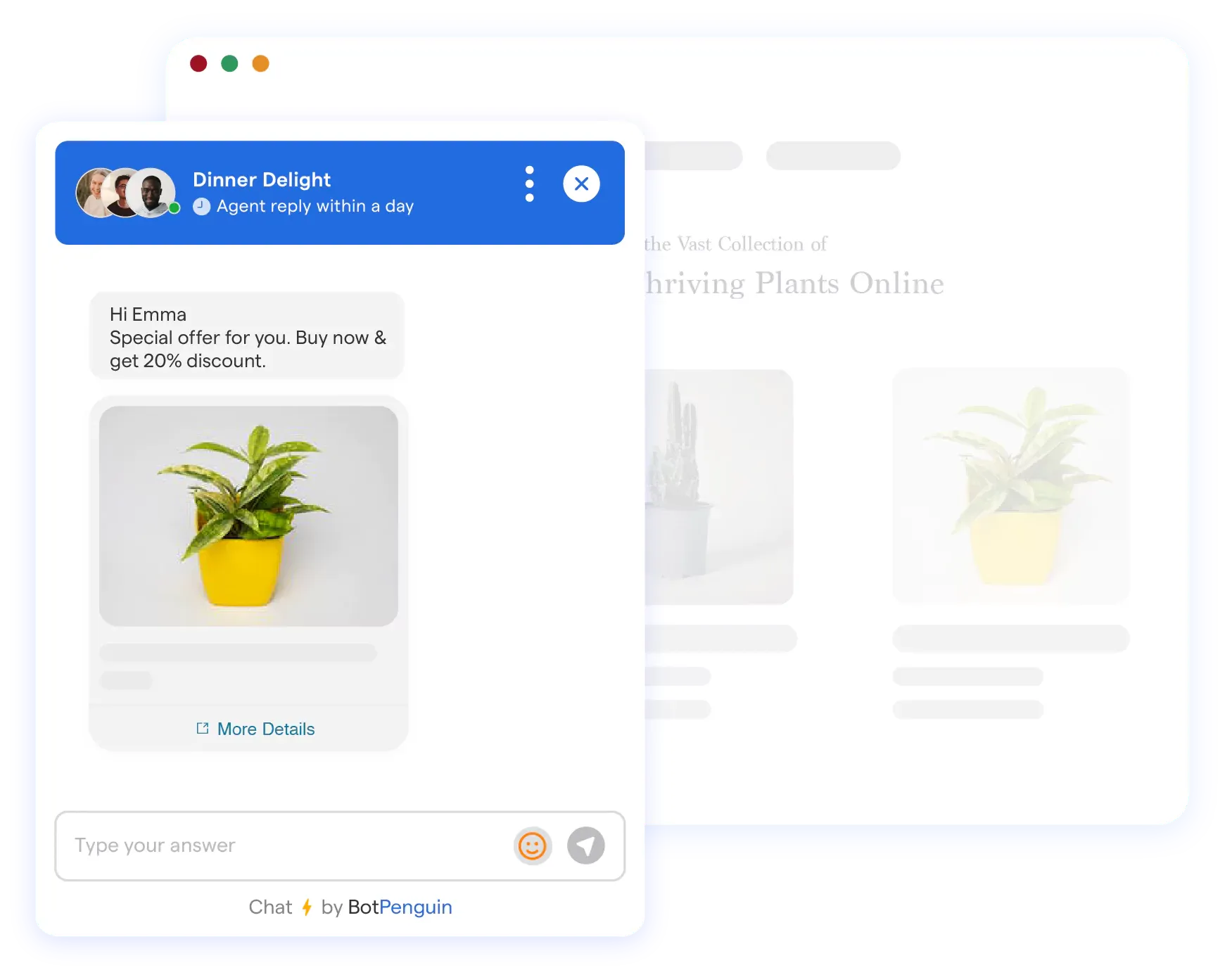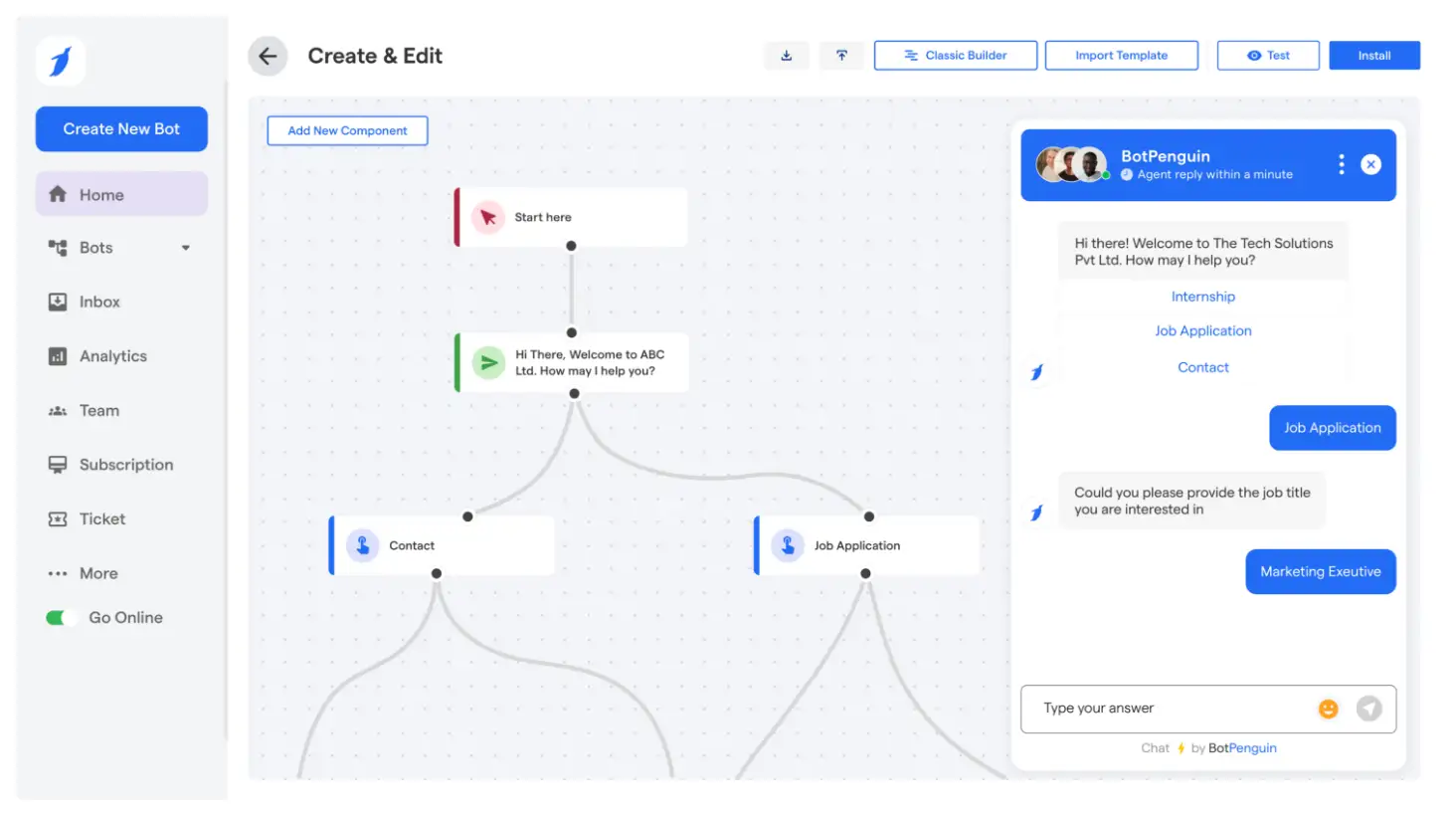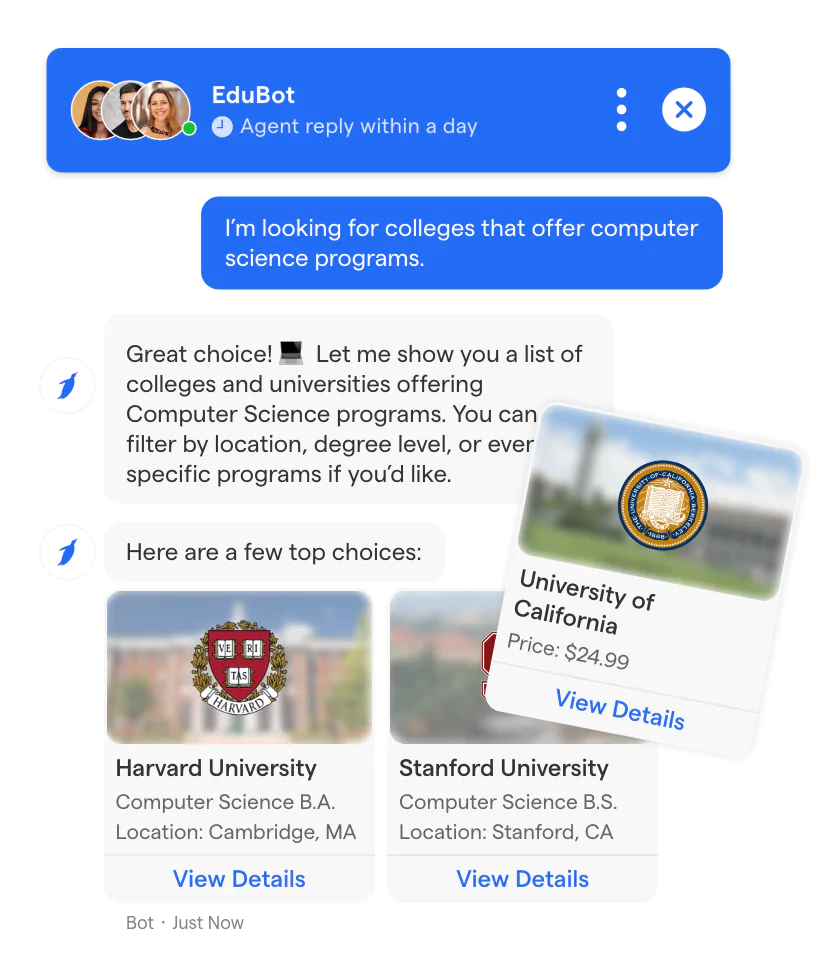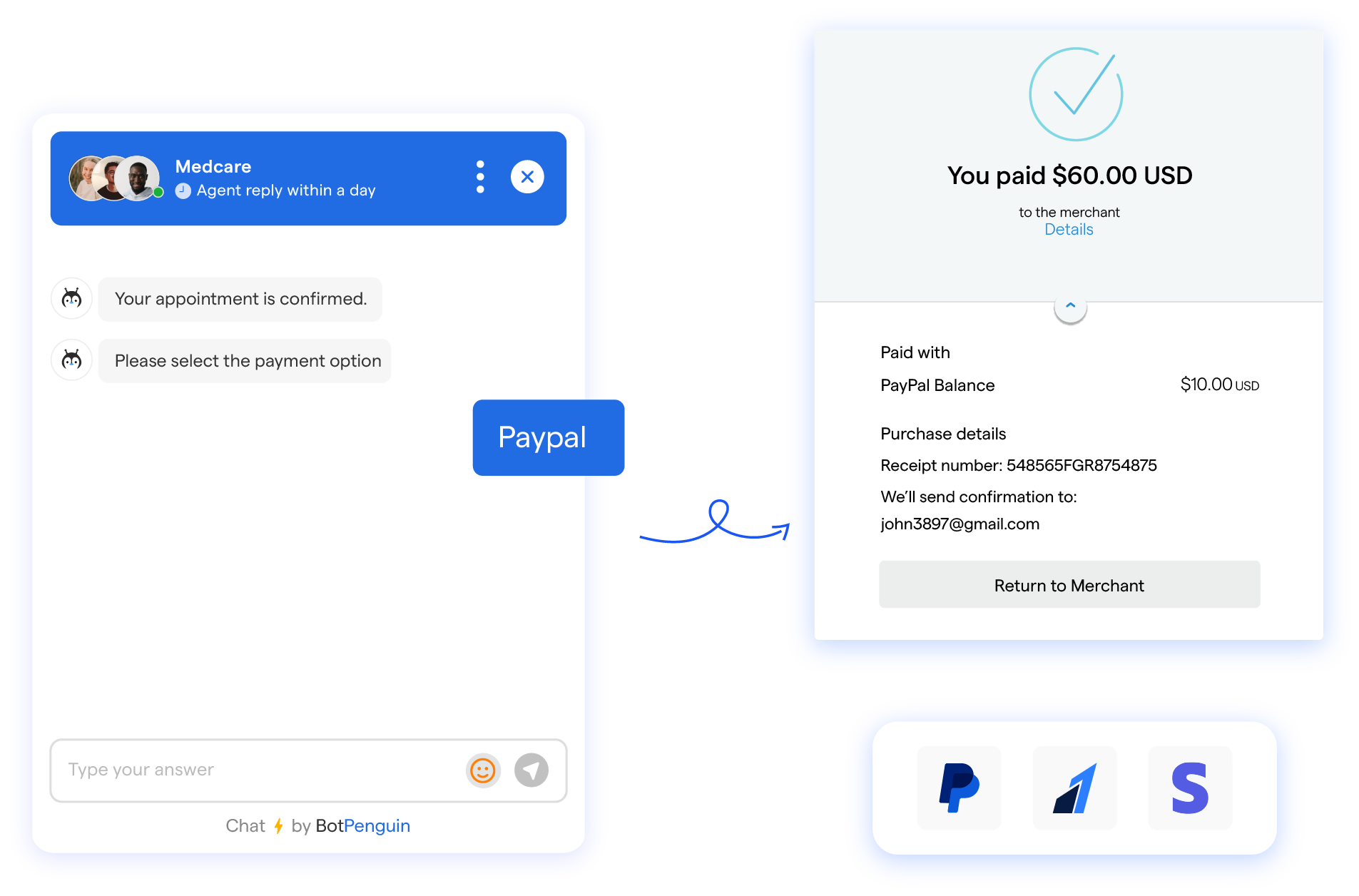Introduction
Chatbots are overrated—or are they?
For years, we've heard claims about chatbots revolutionizing everything from customer service to personal productivity.
But most fail to deliver. They’re clunky, frustrating, and often miss the mark.
That’s where contextual chatbot change the game.
Unlike their predecessors, contextual bots don’t just follow scripts; they understand the conversation. The contextual chatbot adapts, predicts, and responds like a real human would.
Contextual chatbots also improve customer satisfaction rates by up to 25% due to their ability to provide personalized responses. (Source: Salesforce, "State of Service Report")
This guide will unravel how contextual chatbot work, why they’re different, and where they’re making an impact. Continue reading to discover their true potential—and how they might change everything.
What is a Contextual Chatbot?
The contextual chatbot is an advanced AI-driven tool that doesn’t just process individual commands but learns from the entire conversation.

They consider past interactions, user preferences, and the flow of dialogue to provide relevant responses.
Unlike traditional bots, which rely on predefined scripts, contextual bots adapt dynamically. For instance, a contextual chatbot example could be a customer service assistant that remembers your prior complaints and tailors its solutions accordingly. By focusing on contextual chatbot intents, they handle more complex queries seamlessly.
The difference lies in intelligence. Traditional bots are rigid and reactive. Contextual training chatbots, however, evolve with every interaction, making them more efficient and human-like.
Why Context Matters in Conversations
Context is the bridge between mundane exchanges and meaningful interactions. Contextual chatbots excel because they grasp the bigger picture.
Importance of Understanding User Context

Understanding context means recognizing who the user is, what they need, and the nuances of their situation. This transforms generic responses into personalized solutions.
For example, when booking a flight, a contextual chatbot can suggest baggage options based on your previous preferences.
With contextual bots, users experience greater relevance and fluidity in their interactions. These bots don’t just answer—they anticipate. The ability to understand contextual chatbot intents ensures users feel heard and understood.
How Contextual Chatbot Improves User Experience
Context eliminates frustration. Traditional bots often require users to repeat information, but contextual training chatbots remember prior inputs. This improves efficiency and reduces friction.
Consider a contextual chatbot example in e-commerce: A customer searching for “winter jackets” receives tailored recommendations based on their browsing history and location.
By leveraging context, these bots create a seamless journey, enhancing satisfaction and trust.
In a world where personalization is key, context-driven interactions are no longer optional—they’re essential. Contextual chatbot is leading the charge in redefining user engagement.
How Contextual Chatbot Works

As the demand for smarter, more intuitive chatbots grows, understanding how contextual chatbot operates is crucial. These bots don’t just respond—they think.
They rely on advanced AI capabilities to adapt and improve interactions in real time. Let’s break down the mechanics of how these intelligent systems function.
Understanding Context in AI
Context is the foundation of a contextual chatbot. It enables these bots to understand the user beyond a single query. They leverage user intent, history, and real-time data to provide accurate, personalized responses.
- User Intent and History: A contextual chatbot recognizes contextual chatbot intents by analyzing what the user is trying to achieve.
For example, if a user has previously searched for “refund policies,” the bot adapts to offer refund-related information when they return. This ensures conversations are relevant and efficient.
- Real-Time Data Integration: Contextual bots integrate real-time data such as location, device preferences, and even past behaviors.
A contextual chatbot example is one in e-commerce that suggests nearby store availability for a product you’re browsing. This immediate integration makes interactions dynamic and practical.
Key Technologies Behind Contextual Chatbot

Several cutting-edge technologies enable contextual training chatbots to function effectively.
- Natural Language Processing (NLP): NLP allows these bots to interpret and process human language naturally. It breaks down sentences to identify tone, intent, and meaning, forming the backbone of how a contextual chatbot understands queries.
- Machine Learning (ML): With Machine Learning (ML), bots learn and improve over time. They adapt to changing user behaviors and refine their ability to predict contextual chatbot intents, making them increasingly effective.
- Data Storage and Retrieval Systems: Robust storage systems help bots remember past interactions. For example, a customer service contextual chatbot can retrieve details from a previous complaint to address follow-ups with precision.
Examples of Contextual Chatbot Understanding
Contextual bots leverage past interactions and data to provide personalized, efficient, and relevant user experiences.
- FAQs: A contextual chatbot example for FAQs uses prior interactions to prioritize the most relevant answers, skipping redundant questions.
- Customer Support: In customer support, contextual bots can resolve issues faster by using historical data, like previous troubleshooting steps.
- E-commerce: Imagine browsing for winter shoes and the bot not only suggests similar items but also applies your loyalty points. That’s a contextual chatbot using data smartly.
Benefits of Contextual Chatbot
The rise of the contextual chatbot is changing how businesses interact with users. By understanding user needs in real-time, these bots go beyond basic automation.
Let’s explore the tangible benefits they bring to both users and businesses, along with real-world examples.
Improved User Experience

Contextual bots enhance user experience by personalizing interactions, reducing frustration, and providing tailored responses based on user history.
Personalization and Relevance in Responses
A contextual chatbot delivers responses tailored to individual users. Analyzing user history and identifying contextual chatbot intents, ensures interactions feel personalized and engaging.
For example, Spotify’s AI assistant creates curated playlists based on listening habits, while Sephora’s chatbot recommends products tailored to a user’s preferences and previous purchases. This level of relevance improves satisfaction.
Reducing Frustration
Traditional bots often repeat information or fail to adapt. Contextual bots, on the other hand, leverage user context to make conversations seamless.
Uber’s chatbot, for instance, allows users to track rides, check costs, and resolve issues without starting over every time, reducing user frustration and enhancing convenience.
Efficiency in Business Operations

Contextual bots streamline business operations by automating tasks, reducing response times, and enhancing cost-effectiveness through efficient use of resources.
Automating Repetitive Tasks
Businesses save time and resources by deploying contextual training chatbots for routine inquiries.
For example, H&M’s chatbot handles FAQs about store locations, returns, and delivery timelines automatically, freeing up human agents for more complex tasks.
Reducing Response Times
Speed is critical in today’s fast-paced world. A contextual chatbot accesses real-time data to deliver instant answers.
For example, KLM Royal Dutch Airlines uses a contextual bot to provide passengers with flight updates, boarding passes, and gate information in seconds. This efficiency keeps users informed and reduces delays.
Cost-Effectiveness
By automating tasks and optimizing operations, contextual bots reduce the need for large customer support teams.
Banking apps like Capital One’s Eno demonstrate this by handling account queries, fraud alerts, and budgeting tips efficiently, saving the company millions in operational costs.
Enhanced Customer Engagement

Contextual bots enhance customer engagement by fostering trust, encouraging repeat interactions, and building loyalty through personalized, continuous experiences.
- Building Trust Through Tailored Interactions: A contextual chatbot creates trust by making users feel understood.
For example, Duolingo’s chatbot adjusts its responses to match the user’s language level, encouraging learners without overwhelming them. This personalized approach builds trust and engagement.
- Encouraging Repeat Interactions: By maintaining context over time, contextual training chatbots ensure continuity in conversations.
Starbucks’ chatbot remembers past orders, allowing users to quickly reorder their favorites. This simple, personalized touch keeps customers coming back.
- Fostering Loyalty: Tailored responses don’t just solve problems—they build relationships. For example, Amazon’s Alexa uses user data to recommend movies, songs, or smart home routines, making interactions both helpful and delightful. This fosters long-term loyalty.
Real-World Applications of Contextual Chatbot
The contextual chatbot is transforming industries by providing smarter, more personalized interactions.
Their ability to adapt to contextual chatbot intents makes them a powerful tool for improving efficiency and user satisfaction. Here’s how these intelligent systems are being applied across key sectors.
E-commerce

In e-commerce, a contextual chatbot enhances shopping by offering personalized recommendations and recovering abandoned carts through targeted engagement.
Personalized Shopping Recommendations:
A contextual chatbot in e-commerce can suggest products based on browsing history, preferences, and purchase patterns.
For instance, Amazon’s bots recommend items that align with user behavior, driving more sales. This contextual chatbot example shows how bots enhance shopping experiences by delivering relevance.
Assisting in Cart Recovery:
Contextual bots identify abandoned carts and engage users with tailored offers, like discounts or free shipping, to encourage completion.
Shopify-powered stores use contextual training chatbots to follow up with customers, reducing cart abandonment rates and boosting revenue.
Healthcare

In healthcare, a contextual chatbot efficiently answers patient queries and streamlines appointment scheduling, enhancing patient care and staff efficiency.
Patient FAQs:
In healthcare, the contextual chatbot is invaluable for answering common patient questions, like appointment policies or medication instructions.
A contextual chatbot example is Babylon Health, which uses bots to deliver instant, accurate health information, reducing the burden on medical staff.
Appointment Scheduling and Reminders:
By integrating with hospital systems, contextual training chatbots simplify booking appointments and sending reminders.
For instance, HealthTap’s bot ensures patients stay informed about upcoming visits, improving adherence to medical schedules.
Education

In education, a contextual chatbot serve as virtual tutors and guide learners with personalized course recommendations for effective learning.
- Virtual Tutors and Course Recommendations: Contextual bots in education act as virtual tutors, offering explanations and personalized resources.
Duolingo, for example, uses contextual chatbot intents to adapt lessons to each learner’s level, ensuring effective progress.
- Course Recommendations: Educational platforms like Coursera employ contextual training chatbots to guide users toward relevant courses based on their interests and goals, creating a personalized learning journey.
Banking and Finance
In banking and finance, a contextual chatbot simplifies transaction management and offers personalized financial advice, enhancing security and user engagement.
- Transaction Queries: Banking apps like Capital One’s Eno use the contextual chatbot to help users check account balances, view recent transactions, and flag suspicious activity. These bots make financial management simpler and more secure.
- Financial Advice: Bots like Cleo analyze spending patterns to provide budget tips and savings advice. A contextual chatbot example in this space highlights how bots deliver actionable insights, improving financial literacy and user trust.
Customer Support Across Industries
Whether it’s retail, travel, or telecom, contextual bots excel at managing large numbers of customer inquiries.
For instance, KLM Royal Dutch Airlines uses contextual chatbot intents to assist passengers with flight updates, baggage information, and boarding passes, ensuring smoother journeys.
Building a Contextual Chatbot

Building a contextual chatbot is more than coding—it’s about creating a system that understands, learns, and adapts to user interactions.
By following clear steps and using the right tools, businesses can create bots that deliver personalized and efficient experiences.
Steps to Build a Contextual Chatbot
To build a contextual chatbot, start by defining its objectives, then choose the right tools and frameworks to ensure it understands and addresses user needs.
Step 1
Identifying Objectives and Use Cases
The first step is defining the purpose of the contextual chatbot. Will it handle customer inquiries, recommend products, or schedule appointments?
Clearly outline the bot’s goals and its target audience. For example, a contextual chatbot example in healthcare might focus on patient FAQs and appointment reminders.
Step 2
Choosing the Right Tools and Frameworks
Once objectives are clear, select tools and frameworks to build the bot. Opt for platforms that support advanced features like natural language processing (NLP) and integration with third-party systems. This ensures the bot can understand contextual chatbot intents effectively.
4 Popular Contextual Chatbot Platforms and Tools

Here are four popular platforms for building contextual bots:
- BotPenguin: A user-friendly platform for businesses new to chatbot development. BotPenguin offers features for building contextual bots without requiring advanced coding skills.
- Rasa: An open-source framework is ideal for creating highly customized contextual training chatbots. Rasa allows developers to have full control over the bot’s behavior and data handling.
- Dialogflow: Google’s Dialogflow excels at understanding user inputs and detecting contextual chatbot intents. It integrates seamlessly with popular messaging platforms like WhatsApp and Slack.
- Microsoft Bot Framework: Known for its scalability, this framework supports the creation of enterprise-level contextual bots with robust NLP capabilities.
Testing and Deployment
For effective testing and deployment, ensure the contextual chatbot provides:
- Ensuring Accuracy in Responses: Before deployment, test the contextual chatbot thoroughly to ensure it delivers accurate, relevant responses.
Use scenarios that reflect real-world use cases, such as a contextual chatbot example resolving customer complaints.
- Iterative Improvements Based on Feedback: Once live, monitor performance and gather user feedback. Regular updates and fine-tuning, guided by real interaction data, help improve the bot’s ability to understand and address contextual chatbot intents. Iterative improvements keep the bot relevant and efficient.
Challenges and Limitations of Contextual Chatbot

Creating a contextual chatbot comes with its share of challenges. While these bots enhance user interactions, building and maintaining them requires overcoming technical hurdles, addressing privacy concerns, and managing costs.
Here’s a closer look at the key challenges and limitations.
Technical Challenges of Contextual Chatbot
Contextual chatbot intents face difficulties in understanding user context, especially in ambiguous or complex interactions.
Misunderstanding User Context:
Despite advancements, contextual bots may struggle to accurately interpret user intent, especially in ambiguous situations.
For instance, a contextual chatbot example in customer support might fail to differentiate between general inquiries and complaints, leading to irrelevant responses.
Integration with Legacy Systems:
Many businesses rely on outdated systems that are not designed to support modern technologies.
Integrating contextual training chatbots with such systems can be complex and time-consuming, often requiring significant customization and expertise.
Data Privacy Concerns of Contextual Chatbot
Contextual chatbot intents rely on user data, necessitating strong security measures and transparent data handling practices to ensure trust.
Ensuring Secure Handling of User Data:

The contextual chatbot relies on large amounts of user data to function effectively.
This raises concerns about data privacy and security. Businesses must implement robust measures to protect sensitive information, such as encryption and compliance with regulations like GDPR.
Building Trust with Users:
Users may hesitate to share information with contextual bots if they are unsure about how their data will be handled. Clear communication about data policies is essential for building trust.
Cost and Resource Limitations of Contextual Chatbot
The development and maintenance of contextual chatbot intents require significant investment, posing challenges for small businesses with limited resources.
- High Initial Setup and Maintenance Costs: Developing a sophisticated contextual chatbot involves substantial investment in technology, tools, and skilled professionals.
Maintenance costs, including continuous updates and improvements, can add to the financial burden.
- Resource Constraints for Small Businesses: Smaller organizations may lack the budget or technical resources to deploy contextual training chatbots effectively.
This can limit their ability to compete with larger businesses that have access to advanced tools.
Future Trends in Contextual Chatbot

The future of the contextual chatbot is set to redefine how humans interact with technology.
With advancements in AI, integration with smart devices, and the emergence of emotional intelligence, these bots will become even more intuitive and impactful.
Let’s explore the trends shaping this evolution.
Advancements in AI and NLP
Advancements in AI and NLP enable contextual training chatbots to deliver more accurate and personalized user interactions.
Emerging Technologies for Better Contextual Understanding:
AI and Natural Language Processing (NLP) continue to evolve, enabling the contextual chatbot to interpret user inputs more accurately.
Technologies like OpenAI’s GPT models are pushing boundaries by understanding complex contextual chatbot intents and delivering human-like responses.
For example, a contextual chatbot example in customer service could recognize nuanced queries and respond with empathy.
Personalized Experiences at Scale:
Enhanced AI models will allow contextual bots to provide hyper-personalized interactions for millions of users simultaneously.
These improvements will redefine industries like e-commerce and healthcare, where tailored solutions are key.
Integration with IoT and Wearables

Integration with IoT and wearables allows contextual training chatbots to provide personalized, real-time interactions with smart devices.
Seamless Interactions with Smart Devices:
The rise of the Internet of Things (IoT) will expand how contextual training chatbots interact with devices.
For instance, a fitness tracker could communicate with a chatbot to offer tailored workout advice based on activity data. This integration would enable bots to deliver highly specific and relevant recommendations.
Improving Everyday Convenience:
Consider a contextual chatbot example integrated with smart home systems. It could adjust room temperature, set reminders, or even order groceries based on user preferences.
Such seamless connections will make contextual bots indispensable in daily life.
Potential for Emotional Intelligence in Contextual Chatbot

The potential for emotional intelligence in contextual training chatbots allows for more empathetic, human-like interactions that enhance user satisfaction.
Understanding User Emotions and Tones:
Emotional intelligence is the next frontier for the contextual chatbot. By analyzing voice tone, text sentiment, or facial expressions, bots could adapt their responses to match the user’s emotional state.
For example, a mental health contextual chatbot example could offer calming words when detecting distress.
Fostering Deeper Connections:
Emotionally aware contextual bots will improve user engagement by making interactions feel more human.
Imagine a customer support chatbot that not only resolves issues but also reassures and empathizes with frustrated customers. This capability will enhance trust and satisfaction.
The future of the contextual chatbot is bright, driven by advancements in AI, deeper integration with smart devices, and the development of emotional intelligence. These trends promise a new era of intuitive, personalized, and impactful interactions.
Conclusion
In conclusion, the contextual chatbot is revolutionizing the way businesses interact with customers. As it offers personalized, efficient, and impactful solutions.
The contextual chatbot is transforming industries, from e-commerce to healthcare. It does this by enhancing user experiences and streamlining operations.
For businesses looking to embrace contextual chatbot technology, platforms like BotPenguin provide an accessible solution. As a no-code AI chatbot maker, BotPenguin allows companies to build contextual bots tailored to their specific needs without requiring extensive technical expertise.
With BotPenguin, businesses can unlock the potential of contextual training chatbots. It also improves customer engagement.
Stay ahead in an increasingly competitive landscape with the contextual chatbot.
Frequently Asked Questions (FAQs)
What is a contextual chatbot?
A contextual chatbot is an AI-powered tool that understands user intent, past interactions, and real-time data to provide personalized, adaptive, and relevant responses in conversations.
How do contextual chatbots differ from traditional chatbots?
Traditional chatbots follow pre-set scripts, while contextual chatbots adapt dynamically by understanding the user’s history, preferences, and behavior, creating more fluid and meaningful interactions.
What are some real-world applications of the contextual chatbot?
Contextual bots are used in e-commerce for recommendations, healthcare for FAQs and appointments, education for virtual tutoring, and customer support to handle large-scale inquiries efficiently.
What technologies power the contextual chatbot?
Technologies like Natural Language Processing (NLP), Machine Learning (ML), and data integration systems enable contextual training chatbots to understand user intent and deliver personalized responses.
What are the main benefits of the contextual chatbot for businesses?
The contextual chatbot improves user engagement, automates repetitive tasks, reduces response times, enhances personalization, and optimizes operations, leading to higher efficiency and customer satisfaction.
How can businesses build contextual chatbots without coding?
Platforms like BotPenguin, a no-code AI contextual chatbot maker, allow businesses to create contextual bots effortlessly. It provides tailored solutions without requiring technical expertise or significant resources.



